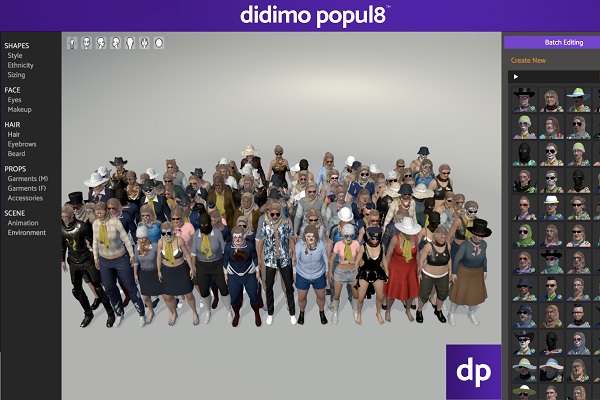Virtual Human Developer Didimo Launches Generative AI Character Creator Popul8

Digital human avatar creator Didimo has launched a new generative AI tool called Popul8 for creating video game characters more quickly and for less money. Popul8 employs generative AI to tweak uploaded templates of characters into hundreds of variations that still fit the style of the game while still being adjustable by the artist.
Popul8 Generate
Popul8 augments Didimo’s existing character creation service, speeding up the design and animation of 3D game characters to less than a minute. Templates of characters from a game are used as a style guide for the AI to ensure its creations fit the virtual world. Artists can play with the look of the new characters with Didm’s character creator tools. With the batch creation option, Popul8 can fill an entire virtual world with characters whose traits are randomized within the aesthetic of a virtual world. Popul8 is also designed to conserve computer memory despite the rapid deployment of hundreds of new characters. The resulting models are in standard formats, so developers can export them and continue working on them with other game tools like ARKit, Unity, and Unreal Engine.
“From research and development over the past decade, we have been able to harness incredible technology in a way that game developers can easily leverage to remove tedious work and focus on building whole new modes of gameplay,” Didimo CEO Veronica Orvalho said in a statement. “And with our continuing focus to make digital spaces available to everyone by allowing more diverse, representative, authentic, and personal engagement, this platform is setting the standard for positive uses of AI generation.”
There are two as-yet-unannounced games arriving soon that use Popul8 and studios like Soleil Game Studios, Sony, tagSpace, and Unstitched using some of the technology on their current projects. The companies using Popul8 own any assets they make with the tool, which they license for each game, with no per-asset cost or hosting fee. Popul8 relies on models and training sources built or licensed by Didimo and doesn’t use ChatGPT, Midjourney, or any open-source databases.
“Our goal with Popul8 is to give studios a powerful AI tool to accelerate high-quality 3D character creation in a fraction of the usual time and cost. With that in mind, our current focus has been working with game developers that would benefit the most from this type of technology which tends to be mid to larger game studios at this point,” Didimo customer application team leader Sean Cooper told Voicebot in an email interview. “Our systems were trained on proprietary data and fully licensed sources. Notably, when customers generate characters, these are wholly unique to that customer. Since Popul8 can ingest the style of a game’s characters, generation can match a game’s aesthetic, making them even more proprietary. Popul8 dramatically reduces game development time, maximizes character budgets, and protects memory budgets for many more in-game characters; game designers can now do much more with their games. We see this as a fundamental tool to game design going forward.
Synthetic media is drawing a lot of attention from the video game industry. Startups like Scenario use generative AI for video game art, while game developer Latitude created AI Dungeon to use advanced language models to produce the game’s text and interact with players through its characters. The game currently uses the Jurassic-1 model created by AI21 Labs. Meanwhile, Google has experimented with using its Imagen text-to-image AI tool to augment classic 1970s text adventure Zork with graphics. Roblox is also experimenting with generative AI tools for game creation, writing the code for objects and their behavior in a virtual environment.
Follow @voicebotaiFollow @erichschwartz
Google Text-to-Image AI Imagen Adds Graphics to 70s Text Adventure Game Zork








